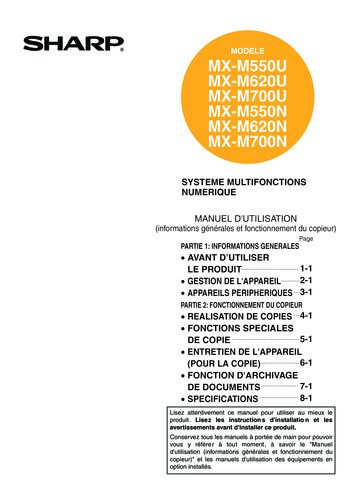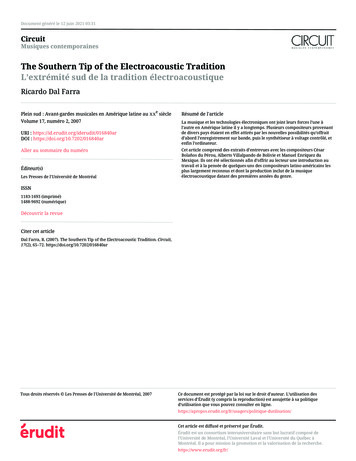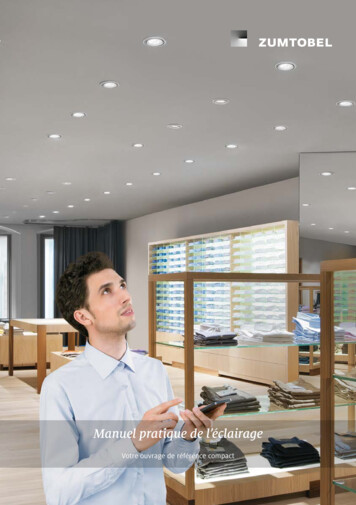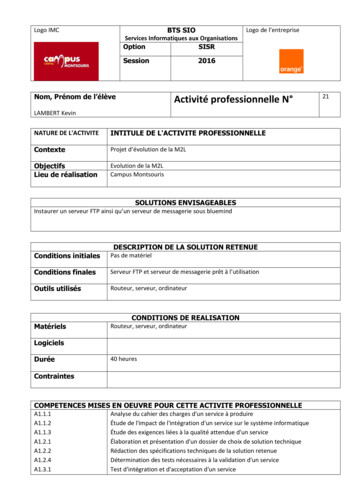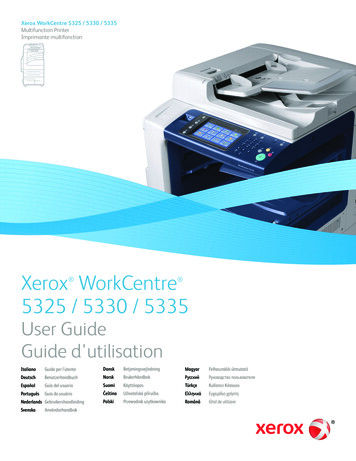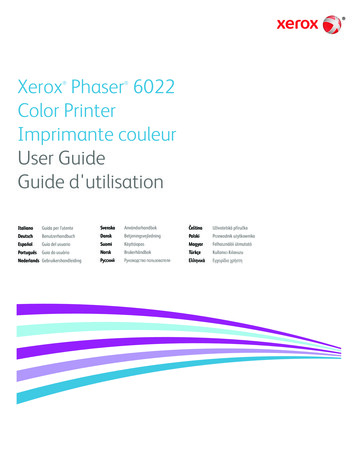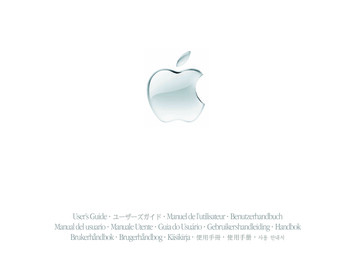
Transcription
User’s GuideManuel de l’utilisateur BenutzerhandbuchManual del usuario Manuale Utente Guia do Usuário Gebruikershandleiding HandbokBrukerhåndbok Brugerhåndbog Käsikirja
Once you’ve set up your iMac and followed the onscreen guide to connect to theInternet, what’s next? Read on to find out how to get the most out of your iMac:2Your iMac at a glance4Mac OS X basics8What you can do with your iMac10Listen to music on your computer or on the go12Create and edit your own movies14Search the Internet16Get more out of the Internet18Send and receive email20Organize, plan, and create22Keep your iMac’s software up-to-date24Learn more and solve problems30Install memory and an AirPort Card32Work more comfortably34Safety, cleaning, and power management1
Your iMac at a glanceYour computer has these built-in features:CD-ROM orCD-RW driveInstall software, useapplications, and listen tomusic CDs. If you havethe CD-RW drive, youcan create yourown CDs. (For use onlywith standard size,circular discs.)Headphones portTwo internalstereo speakersUSB portConnect a USB device,such as a joystick orgraphics tablet.2Microphone Power buttonTurn your computer onor put it to sleep.Volume controlsMedia Eject keyEject a CD.Apple Pro MouseAn optical mouse youcan use on almostany surface.
USBConnect printers, Zipand other disk drives,digital cameras,joysticks, and more.ModemConnect to the Internet,browse the World WideWeb, and send email.FireWireTransfer video froma DV camera. Connectexternal hard disk drives,printers, and scanners.EthernetShare files with anothercomputer and accessa computer network,printer, or the Internet.Sound inputRecord sounds usingan analog microphoneor other audio device.VGA outputConnect an externalmonitor or television forvideo mirroring.Sound outputConnect headphones,external speakers, andanalog audio devices.Access doorInstall additional memoryand an AirPort Card forwireless networking.Reset buttonUse duringtroubleshooting to restartyour computer.To learn more about your iMac’s features:m Choose Mac Help from the Help menu, then clickGo under “Discover my iMac.”3
Mac OS X basicsThe Macintosh desktop is your starting place.Apple menuUse to changesystem settings, openrecent items, and restartor shut down yourcomputer. To see themenu, click the apple( ) in the menu bar.Modem statusUse this menu to connectto and disconnect fromthe Internet usinga dialup modem.Toolbar buttonClick to show or hidethe toolbar.Window buttonsClick the red button toclose the window, theyellow one to minimize itinto the Dock, and thegreen one to resize it.Toolbar iconsClick to navigate quicklyto different folders.Your home foldercontains your personaldocuments.View buttonsClick to see yourfiles as icons, in lists,or in columns.Finder iconClick to open aFinder window soyou can see the filesand applications onyour computer.4To learn more about Mac OS X:m See the Welcome to Mac OS X document in theDocuments folder on your hard disk.TrashDrag an item here todelete it. Items remainhere until you chooseEmpty Trash from theFinder menu.
Application menuShows the name of theapplication you’re using.Use to set preferencesor quit applications (otherthan the Finder).DiscThis appears when a CDis in the disc drive.Double-click the icon tosee what’s on the disc.To eject a disc, press andhold the Media Eject ( )key on the keyboard.ApplicationApplications are softwareprograms (such as agame or word processor)that you use with yourcomputer. Double-clickan application’s icon toopen the application.FolderFolders help organizeyour files andapplications. Doubleclick a folder tosee what’s inside.DocumentDocuments are files thatyou create with anapplication (such as aletter you create with yourword processor). Doubleclick the icon to open thefile in the application usedto create it.DockClick icons in the Dockto open applications,documents, folders,or minimized windows.5
Change the Mac OS to suit your preferences.There are lots of ways to customize Mac OS X.To change Findersettings, choosePreferences from theFinder menu.Choose SystemPreferences fromthe Apple menu tochange most of yourcomputer’s settings.To select a desktopbackground picture, openSystem Preferences andclick Desktop.To change the size ofthe Dock or move it toa different place, openSystem Preferencesand click Dock.To change icon sizesor the background of aFinder window, chooseShow View Options fromthe View menu.6
Click the icons in the Dock or toolbar to find and open files and applications. Drag applications,files, and foldersinto the Dock forone-click access.To set up the toolbar theway you want it, chooseCustomize Toolbar fromthe Finder’s View menu,then drag items tothe toolbar.Press a folder icon tosee its contents and openitems in it.This side of the Dockshows application icons.The triangle indicates theapplication is open.Drag this bar up or down toresize the Dock.This side of the Dockshows files, windows,and folders.7
What you can do with your iMacNot sure how to get the most out of your new iMac? Read on for a few ideas.Make your own CDs. Use iTunesto transfer music from your CD collection. If your iMac hasa CD-RW drive, burn your own music CDs. Transfer music to an iPod or other MP3 player to listenon the go. Make a movie. Shoot video on a DV camcorder and import it into iMovie. Thenrearrange, edit, polish, and add titles and soundtracks. Connect to the Internet to send email andbrowse the Web, or use iToolsto post digital photos on the Web for everyone to see.Browse through the next few pages to find out more.8
The iMac is yourdigital hub.Send digital photos tofriends and family.Import and edithome movies.Put up to 1,000 songs inyour pocket.Send email and surfthe 'Net.Listen to music and burnyour own CDs.Connect to the Internetwirelessly.9
Listen to music on your computer or on the go.Use iTunes to create a library of music and make your own CDs.LibraryYour collection ofsongs, imported fromyour own audio CDs ordownloaded from theInternet. Easily browseor search for music.Portable musicIf you have an AppleiPod, transfer up to1,000 songs forlistening on the go. Goto www.apple.com/ipodfor more information.Radio TunerChoose from hundredsof Internet radiostations – jazz, rock,talk, and more.PlaylistsMake personalizedplaylists using songsfrom your Library.Arrange your music bymood, artist, genre, orhowever you like.Audio CDsPlay an audio CD on yourcomputer. Import songsto your Libraryto play them withoutthe CD.EqualizerAdjust the sound toyour tastes usingthe 10-band EQ with22 presets.To learn more about iTunes:m See iTunes Help, available in the Help menu.m Go to www.apple.com/itunes10
If your computer has a CD-RWdrive, you can create your ownmusic CDs.23. You can fit up to 74 minutes of songs on astandard music CD. To find out which recordable CDswork best with your computer, go towww.apple.com/itunes11.Click the icon in the Dock toopen iTunes.2.Drag songs from the Library to aplaylist. Then click the playlist.3.Click Burn CD and insert a CD-R disc.Then click Burn CD again to start.11
Create and edit your own movies.Use iMovie to edit video from a digital video camera.1.Shoot video with a digital videocamera. Then connect the DV camerausing a FireWire cable.2.In iMovie, bring in your videoclips, then edit and polish theminto movies.3.Export your finished movieback to tape in your DV cameraor to a QuickTime file.To learn more about iMovie:m See iMovie Help, available in the Help menu.m Go to www.apple.com/store to find compatibleDV cameras or to purchase a 6-pin to 4-pinFireWire cable.12
With iMovie, you can add music, voiceovers, titles transitions, and more.iMovie monitorPreview your movie orview video from aconnected DV camera.ShelfClips appear here whenyou import them. Moveclips to the viewerto make them part ofyour movie.Mode switchSwitch betweenimporting from a DVcamera and editing.Editing buttonsClick to open panels foradjusting and selectingsounds, video effects,titles, and transitions.ViewersClick the clip viewer(eye tab) to edit andplace clips. Click thetimeline viewer (clock tab)to edit sound.Playback controlsUse these to play the movie in theiMovie monitor. Click the Play FullScreen button to use theentire screen.13
Search theInternet.22If you know the Internetaddress, you can gothere directly. If you have a dialup connection, you can use themodem status (W) to connect to and disconnectfrom the Internet.To learn more about Internet Explorer:m Open Internet Explorer and chooseInternet Explorer Help from the Help menu.111.14Click the icon in the Dock to openInternet Explorer.2.Type the Internet address and pressReturn on your keyboard.
23Or you can search the Internetwith Sherlock. Click the other buttons to find people, read thenews, shop, and more. Click the hard disk icon to search the files onyour computer.11.Click the icon in the Dock toopen Sherlock.2.Click the Internet icon and typea question in the search field.3.Click the Search button ( ). Thendouble-click an item inthe list of sites.15
Get more out of the Internet with iTools.iTools is a suite of Internet services integrated into Mac OS X.iDiskYour own storage space on Apple’s Internetserver. Share photos, movies, and otherfiles over the Internet. Access your files fromanother Macintosh or PC.HomePageBuild a personal Web site in three easysteps. Create a photo album, publishan iMovie, post your résumé, and more.Anyone can view your site on the WorldWide Web.iCardsSend an elegant iCard, just right for anyoccasion. Choose a ready-made photo, orcreate a personalized iCard using a photoon your iDisk.EmailGet your own Mac.com email address.It’s easy and works with your favoriteemail application.To learn more about iTools:m Go to www.apple.com/itools and click Help on theiTools menu bar. If you signed up for iTools when you first turnedon your computer, you already have an account.Go to www.apple.com/itools to get started.16. To sign up for a new iTools account, openSystem Preferences and click Internet. Thenclick Sign Up.
Store pictures, movies, documents, and other files remotely. To access your files from anothercomputer, log into your iTools account atwww.apple.com/itools1. Anyone can access the files in your Public folder. To find out how to use pictures and otherfiles from your iDisk to create a personal Website, go to www.apple.com/itools and click theHomePage icon.21.Choose iDisk fromthe Go menu.2.Drag files to a folder on your iDiskto copy them.17
Send andreceive email.Follow these steps to createand send a message. To check for new messages, click Get Mail.To view a message, click its subject. If you entered email information or got aMac.com account when you first turned on yourcomputer, Mail is already set up. To set up anew email account, choose Preferences fromthe Mail menu, then click Accounts.11.18Click the Mail icon in the Dockto open the Mail application.
To learn more about Mail:m Open Mail, then choose Mail Help from theHelp menu.m Go to www.apple.com/macosx/applications/mail.html232.To create a new email message,click Compose.3.Type the email address and asubject. Then type your messageand click Send.19
Organize, plan, and create using AppleWorks.Use AppleWorks for writing, drawing, making presentations, and more.Layout capabilitiesAdd photos, tables,charts, and sidebars.Link text frames, layergraphics, and wrap text.Word processingWrite letters, createbrochures, makegreeting cards andparty invitations.Presentation toolCreate an onscreenslide presentation.Add movies, art,graphs, and charts.DatabaseKeep records, saveaddresses, makeinventories. Mergemailing information withthe word processor tosend form letters.20CustomizabletemplatesChoose from a widerange of predesigneddocuments and modifythem as needed.SpreadsheetCompute data easilyusing over 100 built-infunctions, then useformatting options tomake it stand out.PaintingCreate art from scratchor apply effects toexisting picturesor scanned photos.Extensiveclip art librariesChoose from over25,000 high-qualityclip art images.
To get started using AppleWorks:. Click the Web tab to download more templatesfrom the Internet.2To learn more about AppleWorks:m See AppleWorks Help, available in the Help menu.m Go to the AppleWorks Web site atwww.apple.com/appleworks11.Click the icon in the Dockto open AppleWorks.2.Click the type of document you wantto create, or click the Templates tab tomodify a ready-made document.21
Keep your iMac’ssoftware up-to-date.Use Software Update toget the latest updatesand drivers.2. To use Software Update, you must have anInternet connection.11.22Click the icon in the Dockto open System Preferences.2.ClickSoftware Update.
. Click the name of a software item to learnmore about it. You can schedule your computer to checkautomatically for software updates.343.Then clickUpdate Now.4.Select the software you want toupdate and then click Install.23
2Learn moreabout using yourcomputer.3Look in Mac Help formore information on usingyour computer.4. To browse the features of your computer, clickGo under “At a glance.”. Click Quick Clicks topics for answers tofrequently asked questions. To look at Help for other applications, clickthe ? button.2411.Click the Finder iconin the Dock.2.Then choose Mac Help fromthe Help menu.3.Type a questionand click Ask.4.Click an item in the listof Help topics.
These Apple Web sites will help you get the most out of your computer.Macintosh Products Guidewww.apple.com/guideFor great hardware and software productsfor your Mac, check the Web site or look forthe Mac symbol. Also get contact andsupport information for third-party softwaremanufacturers.Apple Storewww.apple.com/storeApple Service and Supportwww.apple.com/supportPurchase the latest Apple and third-party hardware,software, and accessories.Product support, software updates, andtechnical information. From these Web sites you can quickly link toother Apple Web sites around the world.25
Advice and troubleshootingIf you don’t find the answer to your problemon the following pages:Look in Mac Help.m In Mac Help (see page 24), you can find a great deal of troubleshootingadvice, including information to help you solve problems withm Connecting to the Internetm Using software installation and restore discsm Changing your computer’s settingsm Printingm And morem Click the Finder icon in the Dock, then choose Mac Help from theHelp menu. Type a question in the search window (for example,type “How do I eject a disc?”) and click Ask.Switching between Mac OS X and Mac OS 9Your iMac is set to use Mac OS X. Most applications made for Mac OS 9 willwork in the Mac OS X Classic environment. Just open the application asyou normally would. You can also start up your computer using Mac OS 9.To set your computer to use Mac OS 9:m Choose System Preferences from the Apple (K) menu in Mac OS X.m Click the Startup Disk icon to open the Startup Disk pane.26m Select the Mac OS 9 folder as your startup disk. If the icons aredimmed, click the padlock icon and enter the password you chosewhen you first set up Mac OS X.m Click Restart.To set your computer to use Mac OS X again:m Choose Control Panels from the Apple (K) menu.m Open the Startup Disk control panel.m Click the triangle next to the hard disk that contains your operatingsystem folders.m Select the Mac OS X System as your startup disk.m Click Restart.If the computer won’t respond:First, make sure the mouse and keyboard are connected.m Unplug and then plug in the connectors and make sure theyare secure.Then try to cancel what the computer is doing.m Try to force problem applications to quit. Hold down the Option andCommand (x) keys, then press the Esc key. Select the application andclick Force Quit.
If the computer still doesn’t respond, restart it.m Hold the Power ( ) button on the computer for five seconds. Whenthe computer turns off, press the Power button again to restart it.m If that doesn’t work, press the Reset ( ) button.m If that doesn’t work, unplug the power cord from the computer.Then plug the power cord back in and press the Power button onthe computer to turn it on.If you see a flashing question markduring startup:If the computer doesn’t start up after a delay, hold down theOption key and restart your computer.m When your computer starts up, click the hard disk icon, then clickthe arrow.Then do this:Then do this:If the problem occurs frequently when you use aparticular application:After the computer starts up:m Check with the application’s manufacturer to see if it is compatiblewith your computer.m For support and contact information about the software that camewith your computer, go to www.apple.com/guideIf the problem occurs frequently:m You may need to reinstall your system software. Choose Mac Helpfrom the Help menu and type “install system software” for moreinformation.m Open System Preferences and click Startup Disk. Select a localMac OS X System folder.If the problem occurs frequently:m You may need to reinstall your system software. Choose Mac Helpfrom the Help menu and type “install system software” for moreinformation.If the computer won’t turn on or start up:First, make sure the power cord is connected.m Make sure both ends of the power cord are plugged in securely.Make sure the power cord is plugged into a powered electrical outlet.m If your computer is plugged into a power strip, make sure the powerstrip is turned on.27
If that doesn’t work, or if you hear strange sounds duringstartup:If your printer won’t respond or work correctly:m If you recently installed additional memory, make sure that it iscorrectly installed and that it is compatible with your computer.m If that doesn’t work, press the Reset ( ) button, wait a few seconds,and then press the Power ( ) button.m See the service and support information that came with your iMac forinformation on having your computer serviced.Check all cables and connections.If you can’t log into your computer:Make sure you are typing your user name andpassword correctly.m Make sure you are using the same capitalization and punctuation thatyou used originally. Check to see if the Caps Lock key has beenpressed.If that doesn’t work, reset your password.m Insert the Mac OS X software install CD that came with your computer.Restart your computer while holding down the C key. When theInstaller appears, choose Reset Password from the Installer menu andfollow the onscreen instructions.28m Make sure the printer is plugged into the computer and an electricaloutlet. Make sure the printer is turned on.Make sure your computer is set up to use your printer.m Install the software that came with your printer. See the documentationthat came with the printer for instructions.m Open the Print Center application in the Utilities folder. Then selectyour printer.If you can’t eject a CD:Make sure the disc is not in use.m Quit all applications that are using files on the disc.m Then press the Media Eject ( ) key at the top-right corner of thekeyboard.m If that doesn’t work, drag the disc’s icon to the Trash.m If that doesn’t work, restart the computer, then hold down the mousebutton. To restart, choose Restart from the Apple (K) menu.
If you have a problem with a third-partysoftware program:If the Apple Pro Mouse isn’tresponding properly:Make sure the software is compatible with your version ofsystem software.First, make sure the mouse and keyboard are connected.m See the documentation that came with the software. You can check theversion of system software you have by choosing About This Mac fromthe Apple (K) menu.To resolve other problems with software, contact thesoftware manufacturer.m For support and contact information about the software that came withyour computer, go to www.apple.com/guideIf you have a problem with yourInternet connection:First, make sure the telephone line or Ethernet cable isproperly connected to your computer.m Wait a while, then try connecting again.If that doesn’t work, make sure your Internet settings areconfigured correctly.m Unplug and then plug in the connectors and make sure theyare secure.If that doesn’t work, try using the mouse on another surface,like a mouse pad or a notebook.m Non-reflective, opaque surfaces without repetitive patternswork best.If you run out of room and want to keep the mouse clickedwhile you lift it:m Click the mouse, then squeeze the sides with your thumb and fingersand lift the mouse.If the mouse clicks too easily or not easily enough:m Turn the ring on the bottom of the mouse to adjust the tensionof the click.For the latest troubleshooting information, go to theApple Support Web site at www.apple.com/supportm Open the Internet Connect application in the Applications folder tocheck your dialup or AirPort settings. Open System Preferences andclick Network to check your Internet settings.m If you’re not sure of the correct information for your Internet settings,contact your Internet service provider.29
Install memory and an AirPort Card.For detailed instructions, refer to Mac Help (see page 24).1.Open the access door using a coin toturn the latch.Before installing:m shut down the computerm unplug all cables, except the power cordm place the computer face down on a soft cloth302.Touch the metal shield inside therecessed latch area. Then unplug thepower cord.3.To install memory, insert a memorymodule into one of the two lowerslots. Touch this metal before you touch any partsinside the computer. Don’t walk around theroom until you’ve finished installing memory oran AirPort Card. Be sure to align the notches on the module withthe small notches inside the slot.
4.To install an AirPort Card, detach theantenna from the guide rail, thenremove the protective plastic cap.5.Connect the antenna firmly to theAirPort Card and insert the cardsideways into the slot.6.Close the access door and use a cointo close the latch. For instructions on using the AirPort software,look in the Help Center, available in the Helpmenu. Never turn your computer on unless all of itsinternal and external parts are in place.31
Work more comfortably.The guidelines in this section can help you work more comfortably withyour computer. For detailed information about ergonomics,see Apple’s Environmental Health and Safety Web site m When you use the computer keyboard, your shoulders should berelaxed. Your upper arm and forearm should form an approximateright angle, with your wrist and hand in roughly a straight line.m You may have to raise your chair so your forearms and hands are at theproper angle to the keyboard. If this makes it impossible to rest yourfeet flat on the floor, you can use a footrest with adjustable height andtilt to make up for any gap between the floor and your feet. Or you maylower the desktop to eliminate the need for a footrest. Another optionis to use a desk with a keyboard tray that is lower than the regular worksurface.m Use a light touch when typing and keep your hands and fingers relaxed.Avoid rolling your thumbs under your palms.m An adjustable chair that provides firm, comfortable support is best.Adjust the height of the chair so your thighs are horizontal and yourfeet flat on the floor.m The back of the chair should support your lower back (lumbar region).Follow the manufacturer’s instructions for adjusting the backrest to fityour body properly.32m Position the mouse at the same height as your keyboard. Allowadequate space to use the mouse comfortably.Computerm Arrange the computer so the top of the screen is slightly below youreye level when you’re sitting at the keyboard. The best distance fromyour eyes to the screen is up to you, although most people seem toprefer 18 to 28 inches (45 to 70 cm).m Position the computer to minimize glare and reflections on the screenfrom overhead lights and windows.
Don’t lift the computer using the flip-out foot. You coulddamage your computer. To move your computer, grab the handle on thetop of the computer with one hand; with your other hand, hold thebottom of the computer.Important45–70 cm (18–28 in.)Top of the screenat or slightly beloweye level (You mayneed to adjustthe height of yourmonitor by raisingyour worksurface.)ShouldersrelaxedForearmsand handsin a straightlineLower backsupportedScreen positionedto avoid reflectedglareForearmslevel or tilteddown slightlyThighs tilted slightlyFeet flat on the floorClearance underwork surfaceAvoiding fatiguem Change your seated position, stand up, or stretch whenever you startto feel tired. Frequent short breaks are helpful in reducing fatigue.m Use a light touch when typing or using a mouse and keep your handsand fingers relaxed.m Some computer users may develop discomfort in their hands, wrists,or arms after periods of intensive work without breaks.If you begin to develop chronic pain or discomfort in your hands,wrists, or arms, consult a qualified health specialist immediately.m Allow adequate workspace so that you can use your keyboard andmouse comfortably. Place papers or other items so you can view themeasily while using your computer. A document stand may make readingpapers more comfortable.m Eye muscles must work harder to focus on nearby objects.Occasionally focus your eyes on a distant object, and blink often whileyou work.m Clean your screen regularly. Keeping the screen clean helps reduceunwanted reflections.33
Safety, cleaning, and power managementSafetyMake sure that youm keep these instructions handy for reference by you and others whomay use your computerm follow all instructions and warnings regarding your systemWhen setting up and using your computer, remember the following:m Place your computer in a location with adequate ventilation. Neverblock the vents on the computer.m Your computer has a three-wire grounding plug that will only fit agrounded AC outlet. If you are unable to insert the plug into the outlet,contact a licensed electrician to replace the outlet with a properlygrounded outlet.m Make sure you only connect the modem to an analog phone line, thetype commonly used in residences. Do not connect a digital telephoneline to the modem, because it could damage the modem.m Never turn on your computer unless all of its internal and externalparts are in place. Operating the computer when it is open or missingparts can be dangerous and damage your computer.The only way to disconnect power completely is to unplugthe power cord. Make sure at least one end of the power cord is withineasy reach so that you can unplug the computer when you need to.Important34Electrical equipment may be hazardous if misused.Operation of this product must always be supervised by an adult.Do not allow children access to the interior of this product and donot permit them to handle any cables.WarningFor your own safety and that of your equipment, always disconnect thepower plug (by pulling the plug, not the cord) if any of the followingconditions exists:m you want to remove any parts (leave the cord disconnected as long asthe computer is open)m the power cord or plug becomes frayed or otherwise damagedm you spill something into the casem your computer is exposed to rain or any other excess moisturem your computer has been dropped or the case has been otherwisedamagedm you suspect that your computer needs service or repairm you want to clean the case (use only the recommended procedurediscussed in Mac Help)Be sure that you always do the following:m Keep your computer away from sources of liquids, such as drinks,washbasins, bathtubs, shower stalls, and so on.m Protect your computer from dampness or wet weather, such as rain,snow, and so on.
Cleaning your computer equipmentPower-saving and environmental featuresTo clean your computer equipment, use only the recommendedprocedures discussed in Mac Help.Your computer is equipped with energy-saving features that allow it toconserve energy when not in use. For instructions on adjusting the systemand display sleep settings and additional energy-conservation information,see Mac Help.Do not clean the screen with a cleaner that containsalcohol or acetone. Never spray cleaner directly onto the screen.Liquid could drip inside the screen and cause an electrical shock.WarningPower supplyThe power supply in your computer is a high-voltage component and notuser-serviceable. If you suspect the power supply needs service, contactyour Apple-authorized dealer or service provider.ENERGY STAR As an ENERGY STAR partner, Apple has determined that this productmeets the ENERGY STAR guidelines for energy efficiency. The ENERGYSTAR program is a partnership with office product equipmentmanufacturers to promote energy efficiency. Reducing energyconsumption of office products saves money and reduces pollution byeliminating wasted energy.Do not attempt to access the high-voltage area orpower supply. If you suspect the power supply needs service,contact your Apple-authorized dealer or service provider.Warning35
Where’s the fine print?Communications, telephone, and modemregulation informationHigh-risk activities warningFor information on FCC regulations, radio and television interference, andtelephone and modem information related to this product, see the files in theCommunications Regulations folder, inside the Documents folder on your hard disk.This computer system is not intended for use in the operation of nuclear facilities, aircraftnavigation or communications systems, or air traffic control machines, or for any otheruses where the failure of the computer system could lead to death, personal injury, orsevere environmental damage.Laser informationCamera informationWarning Making adjustments or performing procedures other than those specified inyour equipment’s manual may result in hazardous radiation exposure.Do not attempt to disassemble the cabinet containing the laser. The laser beamused in this product is harmful to
2 Your iMac at a glance 4 Mac OS X basics 8 What you can do with your iMac 10 Listen to music on your computer or on the go 12 Create and edit your own movies 14 Search the Internet 16 Get more out of the Internet 18 Send and receive email 20 Organize, plan, and create 22 Keep your iMac



